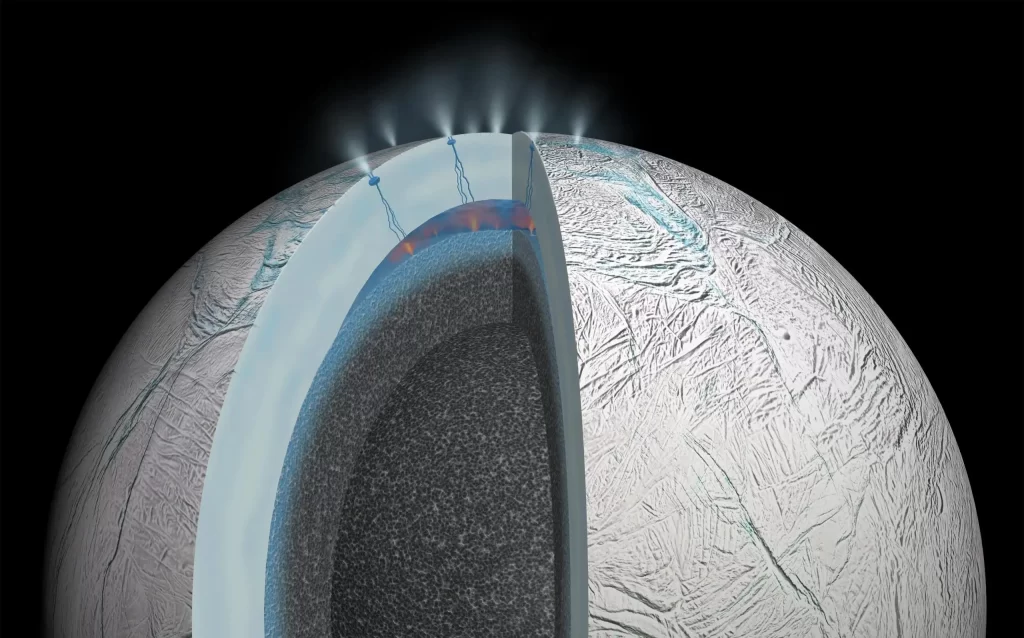The little moon of Saturn called Enceladus has everything. Ongoing geological processes have carefully etched its ice surface. An interior ocean of liquid sits behind its frozen exterior. Warm, chemically charged water seeps from the rocky core of the area and may feed microscopic life on the ocean floor.
More proof has now been found, according to new research published in Nature. It offers the first evidence that phosphorous is present in Enceladus’ ocean, which is a substance necessary for life.
The European Space Agency (Esa) and NASA’s Cassini mission, which was in orbit around Saturn between 2004-17, discovered ice particle plumes escaping from fractures.
These pierce through the frozen shell completely, exposing the ocean water at the bottom of each fissure to space’s vacuum, where the absence of a constraining pressure leads it to bubble and vaporise in the form of plumes.
An unexpected benefit that wasn’t anticipated when the project was first conceived, these plumes supplied samples of spray from Enceladus’ interior ocean that were collected for examination by Cassini during numerous close fly-bys.
During these brief trips through the plumes, particles were collected for analysis, and the results showed that the ice is polluted with small amounts of silica, molecular hydrogen, and simple organic compounds.
Together, these findings suggest that water and warm rock undergo chemical reactions on the ocean floor, most likely at hydrothermal vents (a fissure that releases hot water), which are identical to those on Earth.
This indicates that Enceladus contains everything needed for microbial life to survive (in the absence of sunlight).
In fact, it is thought to be the environment that contributed most to the emergence of life on Earth. It may have happened within Enceladus too if it had occurred on Earth.
All life on Earth needs the six fundamental elements of carbon, hydrogen, nitrogen, oxygen, phosphorous, and sulphide, together abbreviated CHNOPS.

How does phosphorus support life?
Phosphorus has never been identified in Enceladus plume samples, but the other five of these six required elements have.Because it is required for the phosphate groups (phosphorus plus oxygen), which connect the lengthy strands of nucleic acids like DNA and RNA that contain genetic information, phosphorus is an essential component.
Additionally, it enables the storage of energy in cells through the use of molecules such adenoside triphosphate (ATP).
Of course, there is no guarantee that any life on Enceladus, if it exists at all, will require nucleic acids or ATP.
It does, however, make Enceladus a more plausible option given that we are convinced that there is enough phosphorus accessible there since the existence of phosphorus is necessary for life as we know it.
By avoiding the jumbled data gathered during Cassini’s franticly rapid zooms through the plumes, the team was able to locate Enceladus’ phosphorous.
Instead, scientists examined sparser data gathered over a longer period of time by Cassini’s Cosmic Dust Analyzer during 15 occasions between 2004 and 2008 while Cassini travelled through the E-ring, one of Saturn’s rings. As it circles, Enceladus moves along this hoop.
The E-ring hoop has a thickness of almost 2,000 kilometres. The only evidence we have that the plumes were still active five years after the end of the Cassini mission is a recent photograph from the James Webb Space Telescope, which shows that around 30% of the ice particles released in Enceladus’ plumes wind up there.
Nine of the approximately 1,000 ice particles, which are thought to be frozen spray from Enceladus, were confirmed to contain phosphates after the researchers sorted through examinations of them.
This may seem like a meagre finding, but it is sufficient to show that Enceladus’ ocean contains more than enough dissolved phosphorus to support the existence of life.
In fact, additional laboratory research indicates that the amount of dissolved phosphorus in the ocean water of Enceladus may even be hundreds of times higher than that of Earth’s oceans.
According to the research team, any icy moon that formed farther away from the Sun than the Solar System’s carbon dioxide snowline—a location where the temperatures during the formation of planets were low enough for carbon dioxide to freeze—is likely to have a high phosphorus content.
For ice moons at Saturn and beyond, this need is satisfied, but not for those at Jupiter.
Although Jupiter is too close to the Sun and hence too warm to be beyond the carbon dioxide snowline, its distance from the Sun places it beyond the water-ice snowline (beyond which water turns into ice).
What does this mean for missions aiming towards Jupiter’s moon Europa, scheduled to arrive in around 10 years?
The authors of the current study are quiet about this, but their modelling indicates that the interior ocean of Europa has a phosphate content that is a thousand times lower than that of Enceladus.
However, it would be encouraging to see some evidence of phosphorus there as well.



